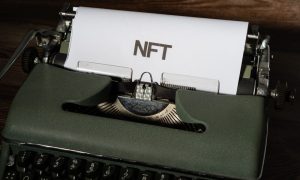On February 22, 2021, an NFT (non-fungible token) sold for $6.6 million. The NFT in question? A looped piece of digital artwork featuring a larger-than-life, despondent, nude President Trump lying face down in some park grass, face hidden, surrounded by garbage like an empty pizza box and a bottle of bleach. In the background, a rainbow arches across the sky and a gentle breeze rustles the leaves of a tree in full bloom.
The former President’s entire body is covered in tattoos like graffiti – some read “Loser” or “MAGA,” others feature his campaign stickers, and one is just the logo for Hot Pockets. While people stroll by on a cobblestone path, seemingly oblivious to the unsettling sight next to them, butterflies flutter all around and a bluebird perches on Trump’s shoulder. Upon landing, a speech bubble blossoms from the bird’s beak containing simply the clown emoji. Then, the bird takes flight and soars out of frame, and the loop repeats.
The artwork, titled CROSSROADS, was created by Mike Winkelmann, an internet artist more commonly known as Beeple. At the time, the $6.6 million price tag made it the most expensive NFT art piece ever sold. As of March 9, 2022, however, it is only #14.
Now, the most expensive NFT art piece sold to date is titled Everydays: The First 5000 Days. The artist? Beeple. On March 8, 2021, just two weeks after CROSSROADS broke the previous record, Everydays: The First 5000 Days sold at Christie’s for an astonishing $69.3 million. Beeple also currently holds the #3 spot on the list with the 2021 sale of Human One for $28.9 million.
Learning these facts raises so many questions, apart from the obvious one: What exactly is an NFT? To keep it simple, as NFTs have been in the news for quite some time now, an NFT is
a digital asset that represents an object – like art, music, an in-game item, or a video – that can be bought and sold online, often with cryptocurrency, and is generally encoded with the same underlying software as many cryptos (that is to say, blockchain).
A more enticing question may be, why are so many NFTs selling for so much money? Are they a reliable store of wealth? Or are they simply the newest version of collectible trading cards? Or perhaps more alarmingly, are they the next Beanie Babies?
Will NFTs experience a meteoric rise in value only to see that price plummet when the next novelty comes along? Some would say this has already, or is already, happening. Prices have certainly slumped since their peaks. However, everything that has to do with crypto or the blockchain always seems to have someone declaring it over and finished just before it experiences a big spike.
The reality is, like baseball cards, Beanie Babies, Pokémon cards, and countless other collectibles items that have seen dazzlingly impressive rises followed by equally dazzling falls, there is nothing altogether unique about NFTs. They have value because people believe they have value, and as soon as that belief evaporates, so does their value. Yes, NFTs offer buyers the distinction of being the sole owners of a Beeple original, or a one-of-a-kind Bored Ape Yacht Club. But is that really much different than being the owner of a Ken Griffey Jr. rookie card, or a Shadowless Holographic Charizard card – or the more mainstream popular Van Gogh or Rembrandt? These all may retain their value for some time, as long as people appreciate baseball or Pokémon or talented Dutch painters, but as they have no practical use, they are still subject to the whims and tastes of collectors.
The most likely scenario is that a tiny fraction of NFTs will remain extremely valuable, while the rest will fade into obscurity – as so many baseball cards and Pokémon cards and works of Dutch painters have – leaving a lot of buyers a lot less wealthy. But this time, they won’t even have anything physical to show for it.






















